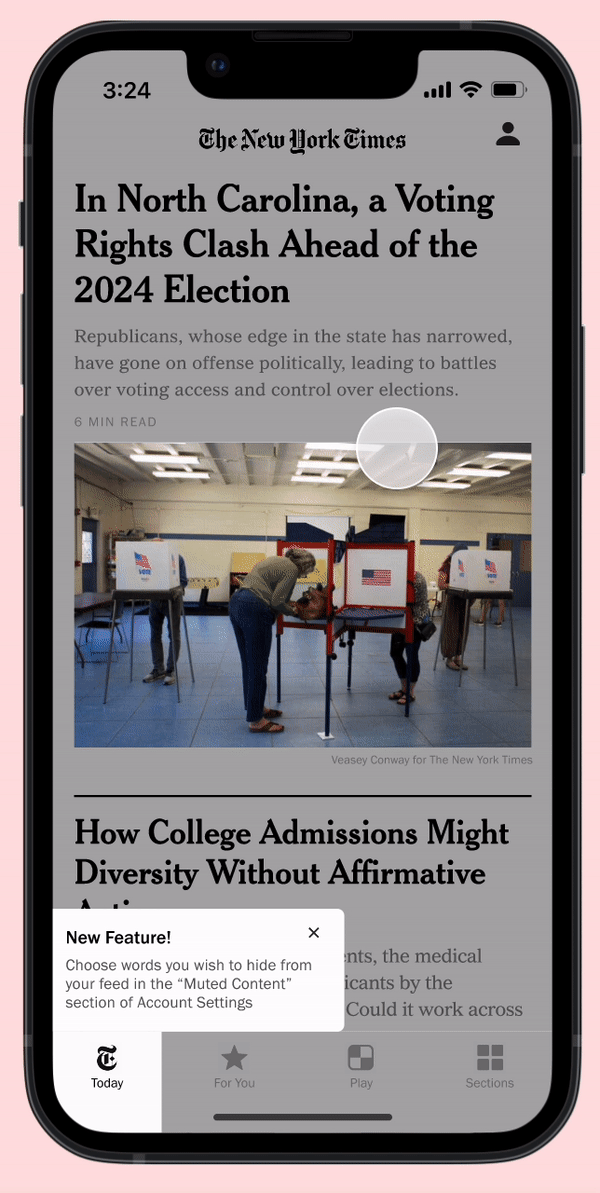
The New York Times News app is used by hundreds of thousands of people daily. A popular app like this one can come with effective features and opportunities for improvement. One of my biggest challenges with reading the news is that I want to stay up to date on current events but so much of the news is distressing and upsetting. To address this issue, I thought of adding a mute content feature, similar to those found on other platforms, to give users greater control over their reading experience.
Goal
Implementing a muted content feature in the New York Times News app could enhance the reading experience by allowing users to filter out content they find triggering, repetitive, or spoiler-related. This feature would allow readers to take control of their news consumption, creating a more personalized and pleasant experience.

How do people engage with the news?
I wanted to speak with avid news readers to understand their motivations for staying up to date with the news, what influences their decision to subscribe to a paid platform, and the emotions they experience while reading. Additionally, I wanted to assess the potential value of a muted content feature and explore if there were other options that might better suit user needs. I conducted three interviews and received 17 responses to a survey that asked these questions.
I did a competitive analysis to explore muted content and word filter features in other apps to guide my design for the Times app. I looked at Facebook, Twitter, and Instagram to see how they let users mute words, how the feature is presented, and how feeds change when it’s turned on. This analysis helped me decide what to include in my design, such as whether to allow muting both words and phrases, and if the muting should apply to photos and videos or just written articles. Since those apps offer this feature and are widely used, I believed it would be a valuable addition to The New York Times app.
I created three personas to better understand the different ways news can be perceived negatively. One example is Monica, a mother who lost her daughter to gun violence. For her, any mention of school shootings, violence, or assault weapons is deeply upsetting and traumatic. Given the frequent coverage of these topics in the news, Monica struggles to engage with current events without being triggered by reminders of gun violence.
How could I improve users' reading experience?
I wanted to find more examples of what users find frustrating about the news and how this feature could improve their reading experience and mental well-being.
Adding a new feature to a distinguished brand
This project had limited creative flexibility since I was developing a feature for a company with an established brand identity. I used the same typography and colors to create a replica of the existing design. For the feature's structure, I applied insights from my competitive analysis. Since the goal of muted content is to enhance the user experience, I aimed for simplicity in the flow. I designed the feature with a limited number of detailed steps to ensure that users can easily understand how to use it, even on their first attempt.
Is this new feature useful?
My goal was to create a feature that would improve the usefulness of The New York Times app and promote positive user experiences, rather than just adding any feature. To assess the potential impact of my work, I conducted a usability test with 12 participants—both subscribers to The New York Times and non-subscribers. This helped me identify what worked and what didn’t in my current flow.
The iterations I made based on the usability test results were straightforward. I added a new introductory screen to notify users about the new feature. I also reworked a few UI elements on the muted feature screens: I enlarged the “Add” button for easier access and added borders to separate the muted words.
The purpose of a muted content feature
The implementation of the muted content feature in The New York Times News app enhances the reading experience by allowing users to filter out content they find triggering, repetitive, or related to spoilers. This feature provides a more personalized reading experience while enabling users to stay informed about current events. By offering this level of customization, the app addresses diverse user needs and fosters a healthier relationship with the news.











